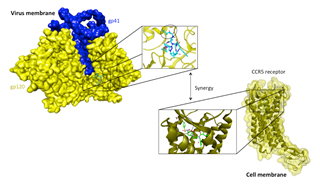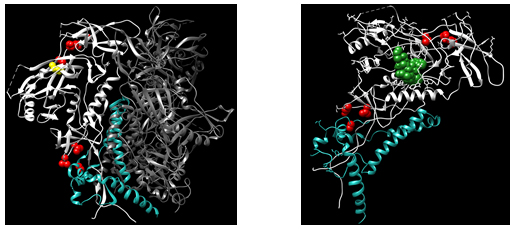Major Ongoing Research Projects

Mechanism-Based Antagonism of HIV-1 Entry into Host Cells
The overall goal of this project is to understand the potential of ligands of the human immunodeficiency virus (HIV-1) gp120 envelope glycoprotein to inhibit virus infection. HIV-1 infection is initiated by entry of the virus into host cells. The entry process depends on attachment of virus with host, and the molecular components of this attachment process are known. HIV-1 cell recognition occurs through envelope proteins on the viral spike, a heterotrimer of the gp120/gp41 complex. The design of antagonists of gp120 interactions with host cell receptors is a central objective of the project. Through a multi-institutional NIH-funded Program Project, we utilize a comprehensive, interdisciplinary and multi-group approach that combines chemical synthesis, high-resolution structure determination, thermodynamic and kinetic binding analyses, cell infection analyses, recombinant mutagenic analyses and computational modeling.

Structure-Based Design of Peptidomimetics Inhibitors of the HIV-1 Envelope gp120 Glycoprotein
The overall goal of this project is the development of a series of small, drug-like peptidomimetics based on the peptide triazole class of compounds that specifically target conserved sites on the HIV-1 gp120 proteins on the viral spike. Peptide triazoles mainly target HIV-1 gp120 and exert their functions through an active pharmacophore composed of three amino acids, and the stacking of this core with the target is stabilized through accessory, yet important interactions through the rest of the peptide amino acid sequence. Through NIH funded projects, we are using peptide chemistry, chemical synthesis and molecular modeling to design and access non-natural peptide analogues with minimized structures, allowing the medicinal chemistry development of a novel class of HIV-1 entry inhibitors. We are also developing a class of cyclic peptide triazoles to overcome the metabolic instability and high flexibility of linear peptides and at the same time, retaining the low toxicity and high specificity of peptide therapeutics.

Lytic Inactivation of HIV-1
The goal of this project is to test the hypothesis that the mature HIV particle can be inactivated by hijacking intrinsic metastability built into the virus spike protein and envelope membrane. We investigate small molecules, recombinant proteins and nanoparticle conjugate constructions that can bind to virus Env and disrupt membrane integrity sufficiently to cause irreversible leakage of viral contents, rendering the virus noninfectious. In a translational project within the Drexel University College of Medicine, we currently seek to design and develop strategies for long-lasting drug delivery vehicles that will target HIV-1 infected cells in addition to free virus.

Synergy of HIV-1 Inhibitors
Preliminary results have argued that multiple, coordinately acting inhibitors targeting the virological synapse of virus Env and cell receptors can improve the potential use of these types of inhibitors in prevention and therapeutic intervention. The phenomenon of synergy for entry inhibitors needs to be better understood as it occurs during virus-host encounter, and maximally active synergy partners need to be identified. In a collaborative project with the Chinese Academy of Science, Shanghai, we seek to identify improved-activity synergistic combinations, evaluate mechanistic properties underlying the synergy, define the potential for antiviral synergy in different cellular environments and evaluate the ability of the synergistic combinations to avoid virus mutagenic escape.

HIV-1 Escape to Peptide Triazoles
The overall goal of this project is to determine the mutational profile in HIV-1 that leads to resistance and neutralization escape to peptide triazole entry inhibitors. Resistance develops quickly for HIV-1 drugs and understanding the likely escape mutations allows for inhibitor optimization, insights regarding mechanism-of-action, and identifying potential inhibitor partners. We are currently using a dose escalation / virus passaging approach to investigate how the virus responds to the presence of virus inactivators and resistance mutation patterns that result.

Epitope-Focused HIV-1 Envelope Vaccine for HIV/AIDS
The overall goal of this project is to explore and advance structurally constrained forms of HIV-1 envelope protein for the development of an HIV-1 vaccine that can be used to achieve HIV-specific immunity. Vaccines that could program the human immune system to recognize and block the envelope protein of the HIV-1 virus have been a major goal of AIDS vaccine development. A current collaborative investigation at Drexel University College of Medicine is under way to identify ways to induce stable exposure of neutralizing epitopes in the spike protein of the virus by Env ligand targeting.

Back to Top